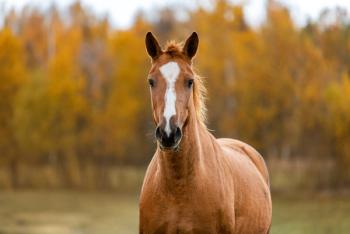
NAHMS Report Traces Lower Levels of Salmonella in Horses
ROCKVILLE, MD.- The National Animal Health Monitoring System (NAHMS) Equine '98 study deviates from prior scientific reports of Salmonella and the U.S. horse population,
ROCKVILLE, MD. - The National Animal Health Monitoring System (NAHMS) Equine '98 study deviates from prior scientific reports of Salmonella and the U.S. horse population, namely because of the horses it sampled, reports the U.S. Department of Agriculture.
Of note is that the NAHMS Equine '98 traced lower levels of fecal shedding of Salmonella in horses than previously reported in other veterinary literature. Of greater note, though, was the NAHMS study sampled horses in a population never before studied.
"The data from NAHMS looks at the prevalence of shedding in the feces of Salmonella and the horse population in general versus trying to establish the status of any given animal in that population," says Dr. Josie Traub-Dargatz, professor at Colorado State University who was involved in writing the report.
Prior to this study, no research had ever closely examined the general population, instead focusing on horses at veterinary hospitals, which are different from the general population, according to Traub-Dargatz.
"Lots of things happen to those horses that come in (to the hospital) for lameness (for example)," says Traub-Dargatz. "They have been hauled and been around other horses that the general population may not have been."
Take-home value
Equine practitioners, who are dealing with a herd of horses, can use the data from NAHMS to determine whether a single horse in the herd which is exhibiting signs of diarrhea from Salmonella signifies a Salmonella problem in the entire herd. If you are looking to establish the infection status of a given horse, you would sample it multiple times, according to Traub-Dargatz.
The data in the study answers the question: "What could you expect the general horse population prevalence of fecal shedding of Salmonella to be?" Traub-Dargatz says. "For an equine practitioner, the value is it (the NAHMS report) gives them an idea of the prevalence in the general population of shedding based on a single sample," she says.
The NAHMS study involved a large number of samples being processed by the same lab. She says that yielded "good uniformity" in collection and lab testing methods across the population.
Core findings
The NAHMS Equine '98 study identified 14 different serotypes of Salmonella species, several that are not associated with illness in horses. The serotype most commonly identified in the U.S. in horses associated with disease is Salmonella typhemerium and that was not the most common type identified in this general population, says Traub-Dargatz. The most prominent serotype in the NAHMS study was Salmonella muenchen.
"This reinforces that what is in the general population is not necessarily the same as the disease population or the hospital population. The real benefit of this data from NAHMS is it gives practitioners an insight to the kind of horses they would more typically see in the field as opposed to what I would see in the clinic (referral or tertiary care cases)," she says.
Data was collected on equine health and management practices from a sample of equine operations in 28 states, which represents about 75 percent of the equine population and 75 percent of operations with equids in the States. Operations were interviewed in the early spring of 1998.
NAHMS collected samples from 8,417 horses on 972 operations with three or more horses to test for shedding of Salmonella.
The overall amount of Salmonella found in grain and concentrates was low. An estimated 0.8 percent of horses shed Salmonella and at least one horse at 1.8 percent of operations shed the organism in its feces, the NAHMS reports.
Prior report data was based on smaller populations or depended on veterinary hospital populations which could have explained the varied findings. In the case of the NAHMS report, all horses, including horse foals, were sampled on locations with less than 10 resident horses, while the number of horses and foals sampled for larger operations varied depending on the size of the operation. All horses were sampled just once.
Each state had horses sampled in the summer and winter. In the summer, shedding prevalence was positive for 1.1 percent of the horses; in the winter, only 0.2 percent of horses were positive for shedding Salmonella.
Dr. Josie Traub-Dargatz
The percentage of locations with at least one horse fecal culture positive for Salmonella ranged from less than 0.1 percent of places with less than six horses to 9.4 percent of locations with 20 plus horses.
The USDA Agricultural Research Service in Athens, Ga., cultured the feces for the NAHMS study.
Other data was recorded in the study, including grain/culture results and assessment of cleanliness of operations. For more information on NAHMS or the Equine '98 study, contact Centers for Epidemiology and Animal Health at (970) 490-8000; e-mail NAHMSweb@usda.gov or visit the Web site at http://www.aphis.-usda.gov/vs/ceah/cahm.
Newsletter
From exam room tips to practice management insights, get trusted veterinary news delivered straight to your inbox—subscribe to dvm360.




